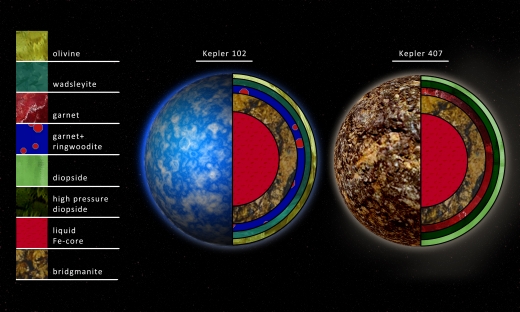What effect does the composition of a star have on the planets that form around it? Enough of one that we need to take it into account as we assess exoplanets in terms of astrobiology. So says a study that was presented at the American Astronomical Society meeting in Texas last week, looking at ninety specific stars identified by Kepler as having evidence of rocky planets.
We know about the composition of these stars because they are part of the 200,000 star dataset compiled by APOGEE, the Apache Point Observatory Galactic Evolution Experiment spectrograph mounted on the 2.5m Sloan Foundation telescope in New Mexico. APOGEE allows us to examine the spectra of stellar atmospheres to identify their elements.
Modeling the formation of planets around these stars shows us the implications for astrobiology. Johana Teske (Carnegie Observatories) explains:
“Our study combines new observations of stars with new models of planetary interiors. We want to better understand the diversity of small, rocky exoplanet composition and structure — how likely are they to have plate tectonics or magnetic fields?”
At the AAS meeting, Teske described how the team of astronomers and geoscientists she is working with focused on Kepler 102 and Kepler 407, the former a star slightly less luminous than the Sun hosting five known planets, the latter hosting two planets orbiting a star of roughly the Sun’s mass. The APOGEE data show that in terms of chemical composition, Kepler 102 is similar to the Sun, while Kepler 407 is much richer in silicon.
Geophysicist Cayman Unterborn (Arizona State) ran computer simulations of planet formation incorporating the APOGEE data. The result:
“We took the star compositions found by APOGEE and modeled how the elements condensed into planets in our models. We found that the planet around Kepler 407, which we called ‘Janet,” would likely be rich in the mineral garnet. The planet around Kepler 102, which we called ‘Olive,’ is probably rich in olivine, like Earth.”

Image: The picture shows what minerals are likely to occur at several different depths. Kepler 102 is Earth-like, dominated by olivine minerals, whereas Kepler 407 is dominated by garnet, so less likely to have plate tectonics. Credit: Robin Dienel, Carnegie DTM.
In Unterborn’s view, the difference is significant because garnet, a far stiffer mineral than olivine, flows more slowly, implying a garnet planet would be unlikely to have long-term plate tectonics. Like the Earth, the planet around Kepler 102 could sustain tectonics, which are thought to be essential for life because atmospheric recycling through geological processes like volcanoes and ocean ridge formation regulates the atmosphere’s composition. Without such geological processes, life would not necessarily have the chance to evolve.
Centauri Dreams‘ take: The interplay of the two datasets — APOGEE and Kepler — is deeply productive, but we’re only at the beginning of the analysis. APOGEE’s 200,000 stars include others known to host small planets, so similar methods can now be put to work on the mineral content of these worlds. Those most Earth-like in their mineral content would rank higher on our list for further astrobiological study, helping us refine our targets for future observation.



This seems like a rather speculative statement. Life evolved quite quickly on Earth, and I find it hard to believe that the early atmospheric gases would have been that different between the 2 models so shortly after the crust formed. In addition, if the deep ocean model of life formation is correct, can the garnet rich model really prevent oceanic vents, rather than just reducing their incidence?
This sort of analysis seems to have more than a hint of the “rare Earth hypothesis” – that life needs conditions just like Earth’s to evolve. Without knowing what the conditions needed are, we should be cautious of following that reasoning.
I would prefer we go in the opposite direction. Use biosignatures to detect life on other worlds, and then use the statistical data to infer the conditions for life, whether stellar composition or other factors.
Some science fiction writers have considered the effects of variations in “cosmic (read “local solar system”) abundance”. I remember a story in an old ASTOUNDING in which a starship crew was marooned on a planet with an oxynitrogen atmosphere where diamonds were so common that heavy machinery wore out with amazing speed because the ambient diamond dust abraded all moving components. Also, I remember a Poul Anderson story that involved a planet where sulfur was so common a mineral you could use melted sulfur as a construction material in place of cement and the concentration of one of the so-called “inert” gases in the atmosphere was high enough to keep one constantly drunk. Some interstellar colonists may be in for a wild ride!
I’m no geologist, but the term “garnet” seems like a bad word choice. Garnets are usually perceived as a gemstone, and we have no idea if this world is a giant gemstone. It would be responsible reporting to explain which elements make up Kepler 407, which lead scientists to believe that it’s “garnet”.
Garnet is the name used for a group of silicate minerals. I’m not aware of another name for this group of minerals, so I’m not sure what alternative would be better.
Can astronomers be certain that the chemical composition of a star and its planets matches the spectrum of the star’s atmosphere?
Perhaps Kepler 407’s spectrum indicates a relative abundance of silicon because a rocky planet or large asteroid plunged onto its surface, temporarily enriching the stellar atmosphere in silicon.
I would have thought the radioactive isotope fraction due to a local super nova event would have been more important than the mantle composition because the radioactive decay is what generates a lot of the heat to keep the interior liquid.
The silicon based Horta would be happiest on one of these garnet worlds. ;)